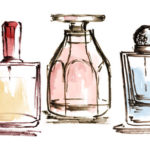Fragrance Basics
If you don’t speak fragrance… have no fear… here is a quick reference guide of common terms/slang used in the fragrance community =)
Basic General Terms
Projection: How far away a fragrance can be smelled from the area it is sprayed on:
- Close to the skin: you have to bring your nose close to your skin to smell it, there is barely any projection. This is great if you are around those with heavy allergies to fragrance, or do not like to smell your fragrance constantly throughout the day. Perfect for intimate evenings where you want to entice your mate to stay close without giving them a headache.
- Moderate Projection: this can be a little subjective as distance is something we all mentally measure differently; for me this is a 1-2 foot range.
- Heavy Projection: This is a beast of a scent that can be smelled the second you walk in the door. For me this is a 3+ foot range. Definitely not something to wear if you want to go unnoticed.
Silliage: (pronounced as see-yazh) A French term to describe how long a fragrance lingers in the air e.g.: When your fragrance leaves a trail behind you as you walk through a room.
**Projection and silliage are often used interchangeably. Their literal definitions are different; oftentimes fragrances with a heavy projection have a strong sillage. This does not mean that fragrances with moderate projection do not do the same.
Notes:
- Top Notes: The initial impression of all perfumes comes from the top notes. Often the most volatile elements in a perfume; intense, tempting, quickly fading.
- Heart (Middle) Notes: This is the second stage, mellower and the story of the fragrance is given meaning before the final stage. This is also known as base notes opening and also known as dry down.
- Base Notes: The third and final stage, the scent that lives on your skin for the entire life span of the perfume.
Dry down: This is where the magic happens; base notes are finally revealed when the perfume has been mixed with the chemistry of the skin. Don’t judge a perfume till you get to this point. This is the stage when you love or hate certain perfume. This is the true face of the perfume itself.
Longevity: The amount of time a fragrance is present. This can vary depending on body chemistry, skin moisture, temperature.
Houses: The company that a perfume is created by. You will often hear or read “From the house of (Insert Company Name Here)”.
Bespoke: Goods made to order- custom fragrances, or those blended when ordered qualify.
Nose: Slang for a perfumer- You will often hear people say “The nose behind this fragrance…”
The Nitty Gritty Specifics
Absolute: A.K.A. Essence- The purest form extracted from a specific flower or plant with the usage of a solvent.
Accord: A blend of at least two separate notes; when combined, create another distinctive scent.
Ambergris: It is sperm whale’s stomach secretion. And while this may sound gross… it is highly prized for its distinctively sweet, woody odor. Often found in synthetic form these days, due to supply vs. demand.
Amber: A chemically derived accord designed to mimic the scent of ambergris. Composed of benzoin (from a Styrax Benzoin tree), labdanum resin (woody scent) and vanilla to create that sweet, mellow soft warmth that drives perfumers crazy. Today 99% of the perfumes contain amber, and the two terms are used interchangeably.
Animalic: Fragrances made with the usage of compounds of animal origin. Musk, castoreum and civet are the most popular compounds of animal origin. *Synthetics are primarily used as many of these animals are on the brink of extinction.
Aromatic: Predominantly green herbs notes like sage, lavender and rosemary.
Balsamic: Heavy, sticky sweet scent that can be associated with balsamic: sweet woody odor with a thick consistency.
Benzoin: Resin derived from the Styrax tree with a balsamic trait – sweet, sticky odor (like rootbeer).
Bergamot: Essential oil derived from bergamot orange. This has a distinct bitter fresh and orange odor.
Camphoraceous: Clean/cooling effect eucalyptus, mint and other green herbal notes have on the skin upon application.
Chypre: Pronounced sheepra- earthy, woody scents. Think forest air after a heavy summer rain.
Citrus: Zesty fresh notes- orange, bergamot and grapefruit.
Compound: A.K.A. perfume oil. The concentrated concoction of the perfume’s mixture of ingredients/ the undiluted stage of the perfume’s life. When bottled, compound is diluted with various solvents; the compound is the virgin state of the fragrance.
Civet: A cat that lives in the African savannas. Perfumers used civet musk extracted from the cat’s anus gland to add warmth and depth. A synthetic version of the ingredient is used these days due to the endangered status of this African mammal and civet musk sky-high price.
Eau de perfume, Eau de toilette and Eau de cologne: terms used to describe strength/dilution.
Essential Oil: A.K.A. Virgin Oils- Highly concentrated essence of plants derived by expression or distillation.
Evanescent: A.K.A. Fleeting fragrances- Often this term goes hand in hand with the notes and is used to mark fragrant notes that evaporate quickly.
Fixative: This is a special ingredient added to deter the evanescent quality of some fragrances. It’s like glue to skin for fragrance.
Floral: Flowery trait when a fragrance is prevalent with floral notes.
Floral-Fruity: Floral with a fruity aspect. This can be a fruity-floral, or floral-fruity situation. You would describe this one based on what you smell first e.g.: starts fruity and dry down is floral= fruity-floral vs. Starts floral and ends fruity= floral-fruity.
Gourmand: Sweet fragrances, often associated with dessert. Dominated by notes such as vanilla, chocolate, caramel, cotton candy, toasted almonds and marshmallows.
Green: Think- the smell of grass, stems and leaves.
Herbaceous or Herbal: Hay or leaf like scents e.g.: dried chamomile or sage.
Hesperidia: All citrus oils.
Ionones: Synthetic compounds used in very small amounts; present in almost in every perfume. They smell like iris or violet flower.
Leathery: The pungent, strong smell that comes from the ingredients used in the process of tanning leather. An animalic quality and a smoky scent.
Mossy: Fragrances with aromatic, earthy notes.
Musk: Glandular secretions from various animals. Derived from the Sanskrit word muska, which means testicle.
Oriental: Exotic aromas such as spices, oakmoss and animal notes.
Ozonic: Think fresh air that lingers in the space after a rain or after a scary summer thunderstorm.
Petally: Soft, a smell and the feel of various flower petals. The classic essence of femininity.
Phenolic: perfumes which are made with a variety of raw and natural materials. Fragrances with strong, penetrating scents heavy in leathery/chocolate/coffee are said to have Phenolic propensities.
Powdery: Think baby powder. Often fragrances that include violet, heliotrope, almond and musk notes are classified as powdery.
White Floral: Includes jasmine, orange blossom, gardenia and tuberose.
Woody: Think fresh cut wood or non woody scents like sandalwood (It smells like dried rose and fresh, rich creamy milk in one)
Zesty: Fresh/bold fragrances like grated citrus peel.
If there is something you would like me to review or add to this page please contact me info@thecriticalvirgo.com
Dont forget to bookmark this site and check out my YouTube channel!
Till then…. Happy sniffing!!!



Comments are closed.